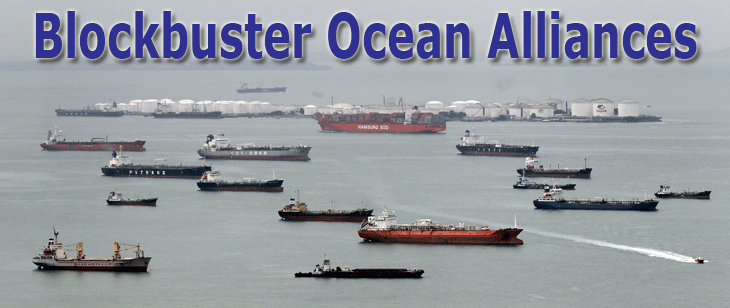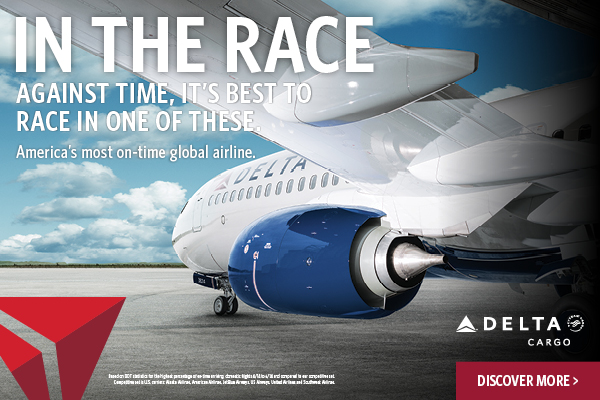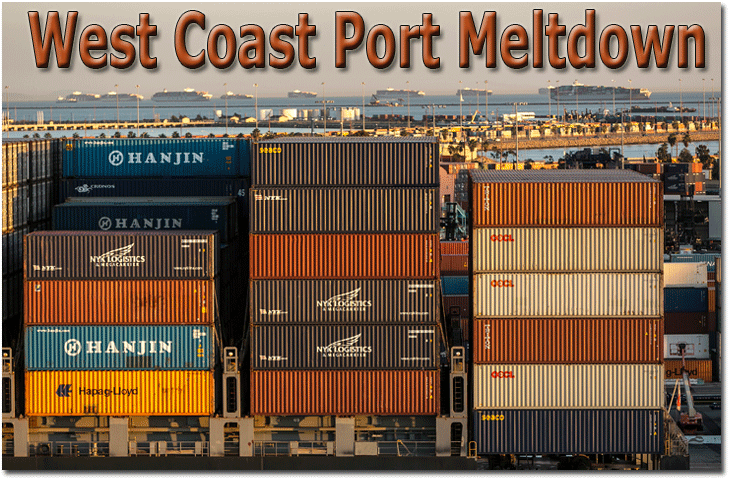
In
early February two of Europe’s largest container lines announced
they would further enhance their cooperation. CMA CGM and Hamburg Süd
were already offering joint services from North Europe to South America
and the Caribbean, but starting in May there will be further cooperation.
Subject to FMC approval, this will see the
lines start a new pendulum service that will connect Asia, the Caribbean,
the United States East Coast, and North Europe. And from July onwards
the lines will, together with further partners, revamp their services
between Asia and both the East and West Coast of South America.
The announcement was significant because
German line Hamburg Süd was the last major line to commit itself
to the mega-alliance model that has carved up global container shipping
capacity in less than a year.
In fact, since Chinese regulators blocked
the huge P3 merger—which would have joined CMA CGM, Maersk, and
MSC— last summer, lines have simply sought out new arrangements
with ever more vigor, rather than discard the strategy.
CMA CGM, the world’s third largest
container carrier with around 9 percent, behind only Maersk (15 percent)
and MSC (13 percent), has been among the most eager to move on to fresh
pastures after the P3 debacle.
What Is Going
On
Apart from its arrangement with Hamburg
Süd, CMA CGM is also now a key member of Ocean Three with China Shipping
and United Arab Shipping Co. Ocean Three represents around 21 percent
of global container capacity, according to Drewry. This compares with
the 2M alliance, which represents 31 percent of the market, and the CKYHE
and G6 alliances with 24 percent of the market each.
In the short period of time since P3 was
blocked, therefore, the global container shipping business has, in effect,
been split into four major alliances supplemented by a range of slot deals
and service arrangements with the few carriers, such as Hamburg Süd,
which had previously refused to follow the crowd.
Driving Factors
The drive behind mega-alliances comes from
lines seeking to lower port and shipping costs and reduce the impact of
excess supply at a time when they still need to invest in new ultra large
container ships which offer reduced fuel usage and greater economies of
scale to remain competitive.
Shippers have generally taken fright at
the thought of such consolidation. Although lines are not allowed to jointly
set prices, they believe that the ability to manage capacity could effectively
stop rates falling freely. They are also concerned that service reliability
and port congestion could both deteriorate.
But so far at least, most of those fears
have proved unfounded. Certainly regulators are keeping a close eye on
pricing arrangements. Rate peaks and troughs at the start of 2015 on key
trades have been marked, but the pattern is not dissimilar to 2014 with
lines continually attempting to implement new rate increases or surcharges
which are then quickly eroded by the market.
Port Issues
Of course, the pricing landscape has been
clouded in the first quarter due to U.S. West Coast port congestion and
union issues, which are taking capacity out of the market and bumping
up prices, and preparations for Chinese New Year, which are adding to
the rush to load ex-China prior to factory closures. Exactly how rates
are being affected by the new mega-alliances will not, therefore, become
clearer until later in the year.
In terms of performance, the mega alliances
do not have to reach too high to improve matters this year compared to
last. According to SeaIntel Maritime Analysis, 19 of 20 shipping lines
recorded a decline in on-time performance during 2014, with CSAV the only
exception.
Word Up
Of the analysts, Drewry has been the early
leader in examining exactly how the mega alliances are influencing liner
behavior on key routes. In one recent report, the analyst found that on
the key Asia-North Europe lane, the four major alliances now control almost
all of the services. However, more positively, the number of services
and available capacity has barely changed.
“Many feared that the formation of
the mega-alliances would intensify the homogenization of the industry
whereby carriers can only compete with one another on price as they all
have the same services,” said Drewry. “However, closer inspection
of the schedules reveals that the alliances are far from uniform and between
them they have created a pretty well-balanced network with wide port coverage
at both ends of the trade.”
Drewry also concluded that for time-sensitive
shippers the alliances were providing a wide array of transit times. From
Shanghai to Rotterdam transit times range from the quickest time being
28 days to the slowest time being 36 days, for example.
“With each alliance having a slight
geographical bias, often dictated by members’ terminals interests,
they all can boast some transit time supremacy somewhere,” said
Drewry.
“Interestingly, the advent of the
new alliances looks to have increased the average speeds of ships on the
trade, which is probably a consequence of both dramatically lower bunker
fuel costs and the desire of carriers to make their new services more
attractive to customers.
“Drewry estimates that average westbound
service speeds have sped up to 18.5 knots; versus 17.8kts as measured
in December. The 2M again leads the way with an average speed of 19.8kts,
while the G6 brings up the rear on 17.5kts.”
However, Drewry adds the caveat that its
analysis was based on scheduled transit times and “shippers will
be well aware carriers do not have a great track record of delivering
cargo on-time” with Drewry’s Carrier Performance Insight finding
that reliability in the Asia-Europe trade was only 64 percent in December.
Looking Ahead
So while the pricing and service implications
of the new liner mega-alliances are still not entirely clear at this early
stage, from a shippers’ point of view, their worst fears have so
far not materialized.
SkyKing
|











